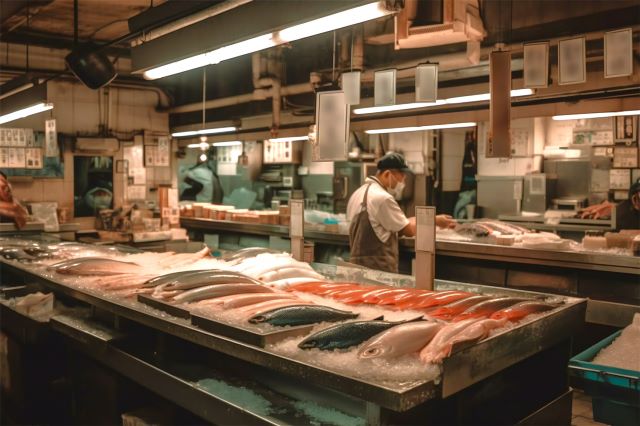
As fish and meat age, their components change, losing their deliciousness while at the same time producing dangerous components that can be harmful to the body. Freshness is determined by the amount of time that has passed since the fish was caught. By knowing the freshness, we can tell how fresh the food is, and at the same time, we can tell if it tastes good and is safe.
To swim, fish consume adenosine triphosphate (hereafter referred to as ATP) in their muscles to generate kinetic energy. While the fish is alive, ATP is resynthesized through respiration and the breakdown of glycogen in the body, even if the muscles are fatigued.
However, if they die and are no longer supplied with new ATP, the binding of actin and myosin, the proteins that make muscles stretch and contract, proceeds unilaterally. In combination with the acidification caused by the breakdown of ATP and the formation of lactic acid, the muscles remain contracted. This is the onset of rigor mortis. Finally, ATP is lost and rigor mortis is completed. If a fish dies while its body is exhausted from strenuous exercise, rigor begins earlier than normal. This means that ATP is consumed when fish resist violently to avoid being caught.
K value is a scientific and objective standard for judging the freshness of fish and other products.
To begin with, the postmortem flesh of fish is said to be alkaline. It becomes more acidic over time. In the process of this change, ATP is broken down into several acids as shown below, and the K value is a mathematical formula that captures some of these acids and calculates them.
ATP→Adenosine diphosphate(ADP)→Adenosine monophosphate(AMP)→inosinic acid(IMP)→hypoxanthine riboside(HxR)→Hypoxanthine(Hx)
The formula is as follows:
K value (%) = (HxR+Hx)/(ATP+ADP+AMP+IMP+HxR+Hx)×100
The rate of degradation varies among fish species, but the pathway to HxR is constant. Fish that die quickly after catching have more ATP, ADP, and AMP. Then, as time passes, IMP increases and finally HxR and Hx increase. These HxR and Hx present a tasteless or bitter taste, which causes a decrease in deliciousness. In other words, a high amount of HxR and Hx is evidence of reduced freshness.
In general, fish with a K value of up to 20% can be eaten raw, i.e., as sashimi. In the case of fish, the K value is about 5% immediately after ikejime. 20-40% is considered to be good freshness. Sushi toppings are around 40%, which is not low by any means, but it is at this value that the flavor of the ingredients is most likely to be extracted. In other words, it is a state of maturing and increased IMP. And if it is 40-60%, it is edible if cooked. In other words, it is better to eat simmered or grilled fish. If it is over 60%, it is in a state of decomposition. Naturally, it is not suitable for eating. It is also known that the rate of increase in K value is large for cod and red-fleshed fish, while the rate of increase in K value is small for white-fleshed fish such as red sea bream and flatfish.
[sc_apply url=”https://sushiuniversity.jp/apply/”]
We hope this information will be helpful.

Revision date: July 25, 2023
Share this article